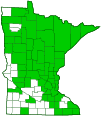wild oats
(Uvularia sessilifolia)
Conservation • Wetland • Description • Habitat • Ecology • Use • Distribution • Taxonomy
Description |
||
Wild oats is a 4″ to 12″ tall, erect, herbaceous perennial rising on a single stem from an elongate, slender rhizome. It often forms colonies. The stems are rounded, forked once above the middle, and have sheathing bracts at the base. They are light green or reddish-green, hairless, are covered with a whitish, waxy coating (glaucous). On young, flowering plants the stem is usually unforked and the upper stem nods under the weight of the leaves and flowers. On mature, fruiting plants the stems are forked once or twice and are reclining. There is usually just a single leaf below the fork of the stem. One branch is sterile and has 4 to 8 leaves, one branch is fertile and has several leaves and 1 to 3 flowers. The leaves are alternate, untoothed, 1½″ to 2½″ long and ⅔″ to 1¼″ wide, oval to oblong egg-shaped, with a pointed tip and a rounded base. They attach to the stem without a stalk (sessile) but do not wrap around the stem at their base. The upper surface of the leaf is hairless and bright green to bluish-green. They have 3 to 5 prominent, parallel veins. On the underside of the leaf the veins are covered with minute white hairs. On young plants the leaves are soft, drooping, and somewhat rolled. On mature plants the leaves are firm and are held horizontally. The inflorescence is a single flower at the end of a flowering branch. It may appear to be born in a leaf axil, since the forked stem on which it is born ends abruptly after forking. The flowers are bell-shaped, ½″ to 1″ long, nodding and slightly fragrant. They are borne on ¼″ to ⅔″ long flower stalks and are subtended with a single bract. There are 6 cream to pale straw-yellow overlapping tepals. The interior surface of the tepals are hairless. The fruit is a 3-celled, greenish to yellowish-brown, ⅔″ to 1⅛″ long, ⅓″ to ⅔″ wide capsule. The capsule is egg-shaped to pyramid-shaped, with a rounded tip and 3 sharp lobes. The lobes are not beaked. Each cell contains several seeds. |
||
Height |
||
4″ to 12″ |
||
Flower Color |
||
Cream to pale straw-yellow |
||
Similar Species |
||
Large-flowered bellwort (Uvularia grandiflora) is a taller plant, 8″ to 20″ tall. The leaves are perfoliate and larger, 2⅓″ to 5⅓″ long and ¾″ to 2″ wide. There are 1 to 3 flowers per stem. The flowers are yellow and larger, 1″ to 2″ long. The seed capsules have well-rounded lobes and are shorter, ⅜″ to ⅔″ long. Perfoliate bellwort (Uvularia perfoliata) has perfoliate leaves. It does not occur in Minnesota. |
||
Habitat |
||
Moderate moisture. Forests edges and openings. |
||
Ecology |
||
Flowering |
||
April to May |
||
Pests and Diseases |
||
|
||
Use |
||
|
||
Distribution |
||||
|
Sources |
|||
| 7/21/2023 | ||||
Nativity |
||||
Native |
||||
Occurrence |
||||
|
||||
Taxonomy |
|||
Kingdom |
Plantae (green algae and land plants) |
||
Subkingdom |
Viridiplantae (green plants) |
||
Infrakingdom |
Streptophyta (land plants and green algae) |
||
Superdivision |
|||
| Division |
Tracheophyta (vascular plants) |
||
Subdivision |
Spermatophytina (seed plants) |
||
Class |
Liliopsida (monocots) |
||
Order |
Liliales (lilies, supplejacks, and allies) |
||
Family |
Colchicaceae (bellworts and allies) |
||
Tribe |
Uvularieae |
||
Genus |
Uvularia (bellworts) |
||
Section |
Oakesiella (sessile-leaved bellworts) |
||
Synonyms |
|||
Oakesia sessilifolia Oakesiella sessilifolia |
|||
Common Names |
|||
pale bellwort sessile bellwort sessileleaf bellwort sessile-leaf bellwort sessile-leaved bellwort small marybells small merrybells straw lily |
|||
Glossary
Beak
A comparatively short and stout, narrow or prolonged tip on a thickened organ, as on some fruits and seeds.
Bract
Modified leaf at the base of a flower stalk, flower cluster, or inflorescence.
Glaucous
Pale green or bluish gray due to a whitish, powdery or waxy film, as on a plum or a grape.
Perfoliate
A leaf having margins that entirely surround the stem, giving the appearance that the stem is growing through the leaf.
Rhizome
A horizontal, usually underground stem. It serves as a reproductive structure, producing roots below and shoots above at the nodes.
Sepal
An outer floral leaf, usually green but sometimes colored, at the base of a flower.
Sessile
Stalkless; attached at the base without a petiole, peduncle, pedicel, or stalk.
Sheath
The lower part of the leaf that surrounds the stem.
Tepal
Refers to both the petals and the sepals of a flower when they are similar in appearance and difficult to tell apart. Tepals are common in lilies and tulips.
Visitor Photos |
|||||
Share your photo of this plant. |
|||||
| This button not working for you? Simply email us at info@MinnesotaSeasons.com. Attach one or more photos and, if you like, a caption. |
|||||
Bill Reynolds |
|||||
Sessileleaf Bellwort St Louis Co MN. I've always known it as Wild Oats. |
|||||
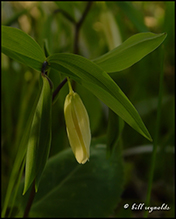 |
|||||
Anne Sundal |
|||||
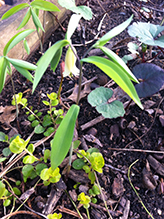 |
|||||
MinnesotaSeasons.com Photos |
|||||
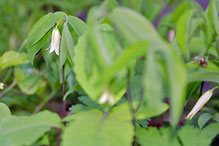 |
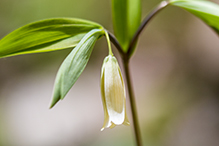 |
||||

Slideshows |
||
Sessile Bellwort (Wild Oats) (Uvularia sessilifolia) |
||
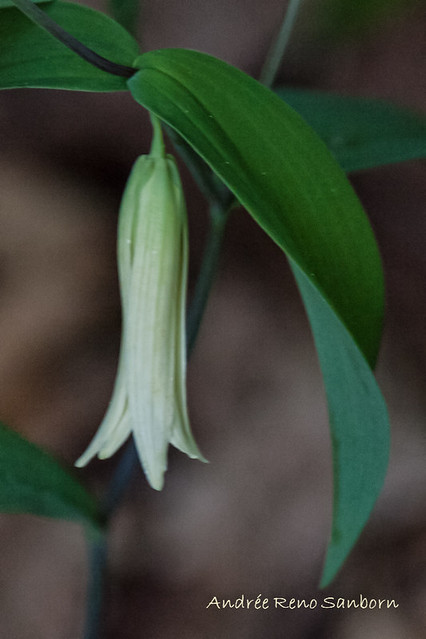
|
||
Uvularia sessilifolia Top # 5 Facts |
||
About
Published on Nov 2, 2015 Uvularia sessilifolia Top # 5 Facts |
||

Visitor Videos |
|||
Share your video of this plant. |
|||
| This button not working for you? Simply email us at info@MinnesotaSeasons.com. Attach a video, a YouTube link, or a cloud storage link. |
|||
Other Videos |
|||
Edible & Medicinal Wild Oats / Bellwort ( Uvularia sessilifolia ) |
|||
About
Published on May 3, 2012 MORE INFO - http://www.sierrapotomac.org/W_Needham/Bellwort_060507.htm http://www.voyageurcountry.com/htmls/floweringplants/plants/bellwortsessile.html http://www.naturalmedicinalherbs.net/herbs/u/uvularia-sessilifolia=bellwort.php http://www.pfaf.org/user/Plant.aspx?LatinName=Uvularia+sessilifolia |
|||
Wild Oats / Bellwort ( Uvularia sessilifolia ) |
|||
About
Published on Jun 30, 2012 Camera used - Toshiba Camileo bw10 |
|||
MyNature Apps; Identifying Wild Oats, Uvularia sessilifolia |
|||
About
Uploaded on May 7, 2011 Identifying Wild Oats, Uvularia sessilifolia. www.mynatureapps.com |
|||

Visitor Sightings |
|||||
Report a sighting of this plant. |
|||||
| This button not working for you? Simply email us at info@MinnesotaSeasons.com. Be sure to include a location. |
|||||
| Anne Sundal 5/21/2014 |
Location: Mahtomedi, MN growing wild in our woodland garden |
 |
|||
| Bill Reynolds 5/28/2004 |
Location: St. Louis Co. MN Sessileleaf Bellwort St Louis Co MN. I've always known it as Wild Oats. |
 |
|||
MinnesotaSeasons.com Sightings |
|||||

|
Created: Last Updated: © MinnesotaSeasons.com. All rights reserved. |
